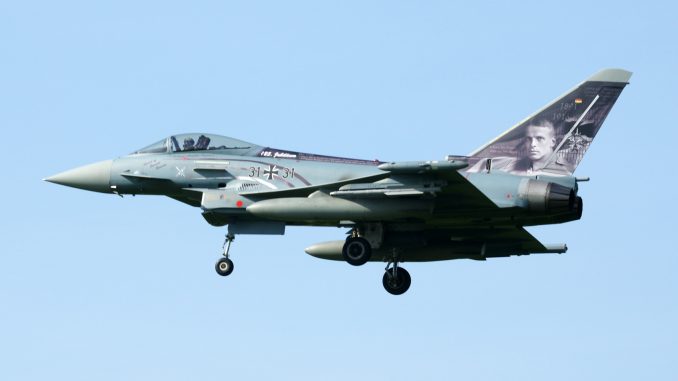
The Eurofighter EF2000 Typhoon is a twin-engine swing role fighter with delta-wing and canards, designed and built by a four nations consortium consisting of British Aerospace (UK), Daimler-Benz Aerospace DASA (Germany), Alenia Aerospazio (Italy), and CASA (Spain).
Initial design of the Eurofighter began in 1986 by the three nations involved in the Tornado project (UK, Germany and Italy) who required an air superiority fighter to counter the next generation of Russian built fighters as the Mikoyan MiG-29 “Fulcrum” and the Sukhoi Su-27 “Flanker” then entering service. One key element of the design was maneuverability during close air combat.
The Eurofighter program began with a one-of prototype the EAP (Experimental Aircraft Program) a technology demonstrator built by British Aerospace with help from Germany to demonstrate some of the systems of the Eurofighter, including the carefree handling fly by wire system, multifunction cockpit-displays and direct voice input. The first flight of the EAP was on August 8, 1986 from BAe Warton with David Eagles in the cockpit. The EAP flew only 165 hours in five years.

The German Eurofighter 98+29 first flight was from DASA’s home base Manching on March 27, 1994 with chief test pilot Peter Weger. It was a 45 minutes flight. The DA1 and DA2 flew the first part of the test flights with the Tornado engine, the Turbo-union RB199. The third prototype (Italian prototype) flew from the beginning with the Euro jet EJ200 turbofans.

The Typhoon incorporates several new state of the art aerial systems including the ECR-90 multirole radar built by companies from all four partner nations and IRIS-T an infra-red search and track weapon aiming system coupled with helmet mounted symbology. Other systems include a defensive Aids sub-system (DASS), wide-angle head up display and VTAS, a Voice Throttle and Stick control system that includes direct voice input of some commands and HOTAS (Hand on Throttle and Stick) to ease the pilots workload.
| Eurofighter Typhoon’s test-fleet: | |||||
| Type | Registration | Configuration | Operator | Manufacturer | First flight |
| EAP | ZF534 | Single | RAF | British Aerospace | Aug. 8, 1986 |
| DA 1 | 98+29 | Single | Luftwaffe | DASA | March 27, 1994 |
| DA 2 | ZH588 | Single | RAF | British Aerospace | April 6, 1994 |
| DA 3 | MMX-602 | Single | AMI | Alenia | June 4, 1995 |
| DA 4 | ZH590 | Dual | RAF | British Aerospace | March 14, 1997 |
| DA 5 | 98+30 | Single | Luftwaffe | DASA | Feb. 24, 1997 |
| DA 6 | XCE-16-01 | Dual | FAE | CASA | Aug. 31, 1996 |
| DA 7 | MMX-803 | Single | AMI | Alenia | Jan. 27, 1997 |
| IPA1 | Dual | British Aerospace | |||
| IPA2 | Dual | Alenia | |||
| IPA3 | Dual | DASA | |||
| IPA4 | Single | CASA | |||
| IPA5 | Single | British Aerospace | |||
| The 5 Instrumented Production Aircraft (IPA)will be flying in the next configurations: | |
| IPA1 | defensive aids sub-system integration |
| IPA2 | air to surface weapon integration sensor fusion |
| IPA3 | air to air weapon integration |
| IPA4 | air to surface weapon integration and environmental trails |
| IPA5 | Air to air and air to surface weapon integration |
Variants:
Tranche 1
- Block 1: Initial Operational Capability and basic Air Defence Capability.
- Block 2: Initial air-to-air capabilities.
- Block 2B: Full air-to-air capabilities.
- Block 5: Full Operational Capability (FOC) by combining existing air-to-air role with air-to-ground capabilities.
Tranche 2
- Block 8: New mission computers required for the integration of future weapons such as Meteor, Storm Shadow and Taurus. (Differences in the build to Tranche 1 related to changes in production technology or obsolescence).
General characteristics: RAF Typhoon
- Crew: 1 (operational aircraft) or 2 (training aircraft)
- Length: 15.96m (52 ft 5 in)
- Wingspan: 10.95m (35 ft 11 in)
- Height: 5.28m (17 ft 4 in)
- Wing area: 50m²(538 ft²)
- Empty weight: 11,000kg (24,250 lb)
- Loaded weight: 15,550kg(34,280 lb)
- Max takeoff weight: 23,500 kg (51,800 lb)
- Powerplant: 2 Eurojet EJ200 afterburning turbofan
- Dry thrust: 60 kN (13,500 lbf) each
- Thrust with afterburner: 90 kN (20,250 lbf) each
Performance
- Maximum speed:
- At altitude: Mach 2+ (2,495 km/h, 1,550 mph)
At sea level: Mach 1.2 (1470 km/h / 913.2 mph) - Supercruise: Mach 1.1-1.5
- At altitude: Mach 2+ (2,495 km/h, 1,550 mph)
- Range: 2,900 km (1,840 mi)
- Combat radius:
- Ground attack, lo-lo-lo: 601 km (373 nmi)
- Ground attack, hi-lo-hi: 1,389 km (863 nmi)
- Air defence with 3-hr CAP: 185 km (115 nmi)
- Air defence with 10-min loiter: 1,389 km (863 nmi)
- Ferry range: 3,790 km (2,300 mi)
- Service ceiling: 19,810 m (65,000 ft)
- Rate of climb: >315 m/s(62,000 ft/min)
- Wing loading: 307 kg/m²(63 lb/ft²)
Armament
- Guns: 1 27 mm Mauser BK-27 cannon with 150 rounds
- Hardpoints: Total of 13: 8 under-wing plus 5 under-fuselage pylon stations holding up to 16,500 lb (7,500 kg) of payload
- Missiles:
- Air-to-air missiles:
- AIM-9 Sidewinder, AIM-132 ASRAAM, AIM-120 AMRAAM, IRIS-T and in the future MBDA Meteor
- Air-to-surface missiles:
- AGM-84 Harpoon, AGM-88 HARM, ALARM, Storm Shadow (AKA “Scalp EG”), Brimstone, Taurus KEPD 350, Penguin and in the future AGM Armiger
- Air-to-air missiles:
- Bombs: Paveway II/III/Enhanced Paveway series of Laser-guided bombs (LGBs), Joint Direct Attack Munition (JDAM), HOPE/HOSBO
- Others:
- Flares/Infrared decoys dispenser pod and chaff pod and
- Electronic countermeasures (ECM) pods
- LITENING III laser targeting pod
- up to 3 drop tanks for ferry flight or extended range/loitering time.
Avionics
- Euroradar CAPTOR Radar
- Passive Infra-Red Airborne Tracking Equipment (PIRATE)



























1 Trackback / Pingback